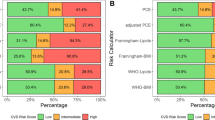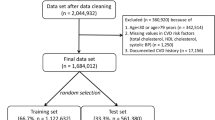Abstract
The aim of this paper is to develop 10-year cardiovascular disease (CVD) risk prediction models for the contemporary Chinese populations based on the Guangzhou Biobank Cohort Study (GBCS) and to compare its performance with models based on Framingham’s general cardiovascular risk profile and the Prediction for Atherosclerotic CVD Risk in China (China-PAR) project. Subjects were randomly classified into the training (n = 15,000) and validation (n = 12,721) sets. During an average of 12.0 years’ follow-up, 3,732 CVD events occurred. A 10-year sex-specific CVD risk prediction model including age, systolic blood pressure, use of antihypertensive medication, smoking, and diabetes was developed. Compared with the Framingham and China-PAR models, the GBCS model had a better discrimination in both women (c-statistic 0.72, 95% CI 0.71–0.73) and men (c-statistic 0.68, 95% CI 0.67–0.70), and the risk predicted was closer to the actual risk. This prediction model would be useful for identifying individuals at higher risks of CVD in contemporary Chinese populations.
Graphical abstract




Similar content being viewed by others
Data Availability
The datasets analyzed during the current study are not publicly available due to the protection of the privacy of the participants but are available from the corresponding author on reasonable request.
Abbreviations
- CVD:
-
Cardiovascular disease
- ASCVD:
-
Atherosclerotic cardiovascular disease
- CHD:
-
Coronary heart disease
- GBCS:
-
Guangzhou Biobank Cohort Study
- China-PAR:
-
Prediction for ASCVD Risk in China
- SBP:
-
Systolic blood pressure
- DBP:
-
Diastolic blood pressure
- BMI:
-
Body mass index
- LDL:
-
Low-density lipoprotein
- HDL:
-
High-density lipoprotein
- AUC:
-
Area under curve
- ROC:
-
Receiver operating characteristic
References
Goff, D. C., Lloyd-Jones, D. M., Bennett, G., et al. (2014). 2013 ACC/AHA guideline on the assessment of cardiovascular risk. Journal of the American College of Cardiology, 63(25), 2935–2959. https://doi.org/10.1016/j.jacc.2013.11.005
DALYs, G. B. D., & Collaborators, H. (2018). Global, regional, and national disability-adjusted life-years (DALYs) for 359 diseases and injuries and healthy life expectancy (HALE) for 195 countries and territories, 1990–2017: A systematic analysis for the Global Burden of Disease Study 2017. Lancet, 392(10159), 1859–1922. https://doi.org/10.1016/S0140-6736(18)32335-3
Ma, L. Y., Chen, W. W., Gao, R. L., et al. (2020). China cardiovascular diseases report 2018: An updated summary. Journal of Geriatric Cardiology, 17(1), 1–8. https://doi.org/10.11909/j.issn.1671-5411.2020.01.001
Du, X., Patel, A., Anderson, C. S., Dong, J., & Ma, C. (2019). Epidemiology of cardiovascular disease in China and opportunities for improvement: JACC International. Journal of the American College of Cardiology, 73(24), 3135–3147. https://doi.org/10.1016/j.jacc.2019.04.036
Michos, E. D., McEvoy, J. W., & Blumenthal, R. S. (2019). Lipid management for the prevention of atherosclerotic cardiovascular disease. New England Journal of Medicine, 381(16), 1557–1567. https://doi.org/10.1056/NEJMra1806939
Grundy, S. M., Stone, N. J., Bailey, A. L., et al. (2019). 2018 AHA/ACC/AACVPR/AAPA/ABC/ACPM/ADA/AGS/APhA/ASPC/NLA/PCNA Guideline on the management of blood cholesterol: A report of the American College of Cardiology/American Heart Association Task Force on Clinical Practice Guidelines. Circulation, 139(25), e1082–e1143. https://doi.org/10.1161/CIR.0000000000000625
Damen, J. A. A. G., Hooft, L., Schuit, E., et al. (2016). Prediction models for cardiovascular disease risk in the general population: Systematic review. BMJ. https://doi.org/10.1136/bmj.i2416
D’Agostino, R. B., Sr., Vasan, R. S., Pencina, M. J., et al. (2008). General cardiovascular risk profile for use in primary care: The Framingham Heart Study. Circulation, 117(6), 743–753. https://doi.org/10.1161/CIRCULATIONAHA.107.699579
Conroy, R. (2003). Estimation of ten-year risk of fatal cardiovascular disease in Europe: The SCORE project. European Heart Journal, 24(11), 987–1003. https://doi.org/10.1016/s0195-668x(03)00114-3
Hippisley-Cox, J., Coupland, C., Vinogradova, Y., et al. (2007). Derivation and validation of QRISK, a new cardiovascular disease risk score for the United Kingdom: Prospective open cohort study. BMJ, 335(7611), 136. https://doi.org/10.1136/bmj.39261.471806.55
Hippisley-Cox, J., Coupland, C., Vinogradova, Y., et al. (2008). Predicting cardiovascular risk in England and Wales: Prospective derivation and validation of QRISK2. BMJ, 336(7659), 1475–1482. https://doi.org/10.1136/bmj.39609.449676.25
Hippisley-Cox, J., Coupland, C., & Brindle, P. (2017). Development and validation of QRISK3 risk prediction algorithms to estimate future risk of cardiovascular disease: Prospective cohort study. BMJ, 357, j2099. https://doi.org/10.1136/bmj.j2099
Woodward, M., Brindle, P., Tunstall-Pedoe, H., & estimation Sgor. (2007). Adding social deprivation and family history to cardiovascular risk assessment: The ASSIGN score from the Scottish Heart Health Extended Cohort (SHHEC). Heart, 93(2), 172–176. https://doi.org/10.1136/hrt.2006.108167
Assmann, G., Cullen, P., & Schulte, H. (2002). Simple scoring scheme for calculating the risk of acute coronary events based on the 10-year follow-up of the prospective cardiovascular Munster (PROCAM) study. Circulation, 105(3), 310–315. https://doi.org/10.1161/hc0302.102575
Assmann, G., Schulte, H., Cullen, P., & Seedorf, U. (2007). Assessing risk of myocardial infarction and stroke: New data from the Prospective Cardiovascular Munster (PROCAM) study. European Journal of Clinical Investigation, 37(12), 925–932. https://doi.org/10.1111/j.1365-2362.2007.01888.x
Bhatnagar, A. (2017). Environmental determinants of cardiovascular disease. Circulation Research, 121(2), 162–180. https://doi.org/10.1161/CIRCRESAHA.117.306458
Zhao, D., Liu, J., Xie, W., & Qi, Y. (2015). Cardiovascular risk assessment: A global perspective. Nature Reviews Cardiology, 12(5), 301–311. https://doi.org/10.1038/nrcardio.2015.28
Ueshima, H., Sekikawa, A., Miura, K., et al. (2008). Cardiovascular disease and risk factors in Asia: A selected review. Circulation, 118(25), 2702–2709. https://doi.org/10.1161/CIRCULATIONAHA.108.790048
Kim, A. S., & Johnston, S. C. (2011). Global variation in the relative burden of stroke and ischemic heart disease. Circulation, 124(3), 314–323. https://doi.org/10.1161/CIRCULATIONAHA.111.018820
Wang, W., Zhao, D., Liu, J., et al. (2003). Prospective study on the predictive model of cardiovascular disease risk in a Chinese population aged 35–64. The Chinese Journal of Cardiology, 31(12), 902–908. https://doi.org/10.3760/j:issn:0253-3758.2003.12.006
Zhang, X. F., Attia, J., D’Este, C., Yu, X. H., & Wu, X. G. (2005). A risk score predicted coronary heart disease and stroke in a Chinese cohort. Journal of Clinical Epidemiology, 58(9), 951–958. https://doi.org/10.1016/j.jclinepi.2005.01.013
Wu, Y., Liu, X., Li, X., et al. (2006). Estimation of 10-year risk of fatal and nonfatal ischemic cardiovascular diseases in Chinese adults. Circulation, 114(21), 2217–2225. https://doi.org/10.1161/CIRCULATIONAHA.105.607499
Chien, K. L., Su, T. C., Hsu, H. C., et al. (2010). Constructing the prediction model for the risk of stroke in a Chinese population: Report from a cohort study in Taiwan. Stroke, 41(9), 1858–1864. https://doi.org/10.1161/STROKEAHA.110.586222
Yang, X., Li, J., Hu, D., et al. (2016). Predicting the ten-year risks of atherosclerotic cardiovascular disease in chinese population: The China-PAR project. Circulation, 134(19), 1430–1440. https://doi.org/10.1161/CIRCULATIONAHA.116.022367
Hu, W. S., Lee, J. H., Tsai, M. K., & Wen, C. P. (2017). A novel cardiovascular death prediction model for Chinese individuals: A prospective cohort study of 381,963 study participants. Atherosclerosis, 264, 19–28. https://doi.org/10.1016/j.atherosclerosis.2017.07.016
Li, J., Zhao, H., Song, B., et al. (2017). Risk prediction model of cardiovascular disease based on health management cohort. Journal of Shandong University ( Health Sciences), 55(6), 56–65. https://doi.org/10.6040/j.issn.1671-7554.0.2017.356
Xing, X., Yang, X., Liu, F., et al. (2019). Predicting 10-year and lifetime stroke risk in Chinese population. Stroke, 50(9), 2371–2378. https://doi.org/10.1161/STROKEAHA.119.025553
Yang, L., Wu, H., Jin, X., et al. (2020). Study of cardiovascular disease prediction model based on random forest in eastern China. Science and Reports, 10(1), 5245. https://doi.org/10.1038/s41598-020-62133-5
Zhao, D., Liu, J., Wang, M., Zhang, X., & Zhou, M. (2019). Epidemiology of cardiovascular disease in China: Current features and implications. Nature Reviews Cardiology, 16(4), 203–212. https://doi.org/10.1038/s41569-018-0119-4
Jiang, C., Thomas, G. N., Lam, T. H., et al. (2006). Cohort profile: The Guangzhou Biobank Cohort Study, a Guangzhou-Hong Kong-Birmingham collaboration. International Journal of Epidemiology, 35(4), 844–852. https://doi.org/10.1093/ije/dyl131
Xu, L., Jiang, C. Q., Schooling, C. M., et al. (2014). Prediction of 4-year incident diabetes in older Chinese: Recalibration of the Framingham diabetes score on Guangzhou Biobank Cohort Study. Preventive Medicine, 69, 63–68. https://doi.org/10.1016/j.ypmed.2014.09.004
Wang, T., Jiang, C. Q., Xu, L., et al. (2018). White blood cell count and all-cause and cause-specific mortality in the Guangzhou biobank cohort study. BMC Public Health, 18(1), 1232. https://doi.org/10.1186/s12889-018-6073-6
Xu, L., Lam, T. H., Jiang, C. Q., et al. (2019). Egg consumption and the risk of cardiovascular disease and all-cause mortality: Guangzhou Biobank Cohort Study and meta-analyses. European Journal of Nutrition, 58(2), 785–796. https://doi.org/10.1007/s00394-018-1692-3
Sullivan, L. M., Massaro, J. M., & D’Agostino, R. B., Sr. (2004). Presentation of multivariate data for clinical use: The Framingham Study risk score functions. Statistics in Medicine, 23(10), 1631–1660. https://doi.org/10.1002/sim.1742
D'Agostino RB and Nam B-H. (2003). Evaluation of the performance of survival analysis models: Discrimination and calibration measures. 23: 1-25. https://doi.org/10.1016/s0169-7161(03)23001-7
Li XH, Song JC, Lin T, et al. (2016). Urbanization and health in China, thinking at the national, local and individual levels. Environ Health-Glob, 15 ARTN 32 https://doi.org/10.1186/s12940-016-0104-5
Miao, J., & Wu, X. (2016). Urbanization, socioeconomic status and health disparity in China. Health & Place, 42, 87–95. https://doi.org/10.1016/j.healthplace.2016.09.008
Liu, J. H. Y., D’Agostino, R. B., Sr., Wu, Z., Wang, W., Sun, J., Wilson, P. W., Kannel, W. B., & Zhao, D. (2004). Predictive value for the Chinese population of the Framingham CHD risk assessment tool Compared with the Chinese Multi-provincial Cohort Study. JAMA, 291, 2591–2599.
Ruwanpathirana, T., Owen, A., & Reid, C. M. (2015). Review on cardiovascular risk prediction. Cardiovascular Therapeutics, 33(2), 62–70. https://doi.org/10.1111/1755-5922.12110
Virginia, M. M., Margaret, M. R., & Joseph, P. M. (2007). Use of BNP and CRP as biomarkers in assessing cardiovascular disease: Diagnosis versus risk. CurrVascPharmacology, 5(1), 15–25. https://doi.org/10.2174/157016107779317251
Fox, E. R., Samdarshi, T. E., Musani, S. K., et al. (2016). Development and validation of risk prediction models for cardiovascular events in black adults: The Jackson Heart Study Cohort. JAMA Cardiol, 1(1), 15–25. https://doi.org/10.1001/jamacardio.2015.0300
Ravnskov, U., Diamond, D. M., Hama, R., et al. (2016). Lack of an association or an inverse association between low-density-lipoprotein cholesterol and mortality in the elderly: A systematic review. British Medical Journal Open, 6(6), e010401. https://doi.org/10.1136/bmjopen-2015-010401
Liang, Y., Vetrano, D. L., & Qiu, C. (2017). Serum total cholesterol and risk of cardiovascular and non-cardiovascular mortality in old age: A population-based study. BMC Geriatrics, 17(1), 294. https://doi.org/10.1186/s12877-017-0685-z
Lee, S. H., Kim, D. H., Park, J. H., et al. (2018). Association between body mass index and mortality in the Korean elderly: A nationwide cohort study. PLoS ONE, 13(11), e0207508. https://doi.org/10.1371/journal.pone.0207508
Khattar, R. S., Swales, J. D., Dore, C., Senior, R., & Lahiri, A. (2001). Effect of aging on the prognostic significance of ambulatory systolic, diastolic, and pulse pressure in essential hypertension. Circulation, 104(7), 783–789. https://doi.org/10.1161/hc3201.094227
Benetos, A., Petrovic, M., & Strandberg, T. (2019). Hypertension management in older and frail older patients. Circulation Research, 124(7), 1045–1060. https://doi.org/10.1161/CIRCRESAHA.118.313236
Wells G, Shea B, O'Connell D, et al. The Newcastle-Ottawa Scale (NOS) for assessing the quality of nonrandomised studies in meta-analyses http://www.ohri.ca/programs/clinical_epidemiology/oxford.asp
Acknowledgements
The Guangzhou Biobank Cohort Study investigators include the following: Guangzhou Twelfth People’s Hospital, WS Zhang, M Cao, T Zhu, B Liu, and CQ Jiang (Co-PI); The University of Hong Kong, CM Schooling, SM McGhee, GM Leung, R Fielding, and TH Lam (Co-PI); and The University of Birmingham, P Adab, GN Thomas, and KK Cheng (Co-PI).
Funding
This work was funded by the Natural Science Foundation of China (No. 81941019), the Major Infectious Disease Prevention and Control of the National Science and Technique Major Project (2018ZX10715004), the National Key R&D Program of China (2017YFC0907100), the Natural Science Foundation of Guangdong (2018A030313140), the Guangzhou Science and Technology Bureau (201704030132), and the University of Birmingham, UK.
Author information
Authors and Affiliations
Contributions
Ying Yue Huang, Wen Bo Tian, Chao Qiang Jiang, Wei Sen Zhang, Feng Zhu, Ya Li Jin, Tai Hing Lam, Lin Xu, and Kar Keung Cheng have substantial contributions to conception and design, acquisition of funding and data, and interpretation of data; YYH, THL, and LX analyzed the data; WBT, LX, and KKC drafted the article; YYH, WBT, THL, LX, and KKC revised it critically for important intellectual content; and all authors contributed to final approval of the paper.
Corresponding authors
Ethics declarations
Consent to Participate
The Guangzhou Medical Ethics Committee of the Chinese Medical Association approved the study, and all participants gave written, informed consent before participation.
Competing Interests
The authors declare no competing interests.
Additional information
Communicated by Associate Editor Junjie Xiao oversaw the review of this article.
Publisher’s Note
Springer Nature remains neutral with regard to jurisdictional claims in published maps and institutional affiliations.
Supplementary Information
Below is the link to the electronic supplementary material.
Rights and permissions
About this article
Cite this article
Huang, Y.Y., Tian, W.B., Jiang, C.Q. et al. A Simple Model for Predicting 10-Year Cardiovascular Risk in Middle-Aged to Older Chinese: Guangzhou Biobank Cohort Study. J. of Cardiovasc. Trans. Res. 15, 416–426 (2022). https://doi.org/10.1007/s12265-021-10163-3
Received:
Accepted:
Published:
Issue Date:
DOI: https://doi.org/10.1007/s12265-021-10163-3




